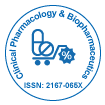Exploring Postmortem Clinical Pharmacology: Insights beyond Death
Received: 01-Mar-2024 / Manuscript No. cpb-24-132730 / Editor assigned: 04-Mar-2024 / PreQC No. cpb-24-132730(PQ) / Reviewed: 22-Mar-2024 / QC No. cpb-24-132730 / Revised: 22-Mar-2024 / Manuscript No. cpb-24-132730 / Accepted Date: 29-Mar-2024 / Published Date: 29-Mar-2024 DOI: 10.4172/2167-065X.1000425
Abstract
Postmortem clinical pharmacology represents a vital component of forensic medicine, offering valuable insights into drug-related deaths, toxicological profiles, and pharmacokinetic parameters in deceased individuals. This abstract explores the significance of postmortem clinical pharmacology, its methodologies, applications, and ethical considerations in forensic investigations. By employing sophisticated analytical techniques, forensic pharmacologists contribute to elucidating the cause and manner of death, assessing drug-related risks, and advancing forensic science. Despite challenges and ethical considerations, postmortem pharmacology continues to play a critical role in ensuring justice and public health safety beyond death.
Keywords: Postmortem clinical pharmacology; Forensic medicine; Toxicological profiles; Forensic investigations
Keywords
Postmortem clinical pharmacology; Forensic medicine; Toxicological profiles; Forensic investigations
Introduction
Postmortem clinical pharmacology, the study of drugs and their effects in deceased individuals, offers valuable insights into medication use, drug toxicity, and cause of death. While traditional pharmacological studies focus on living subjects, postmortem investigations provide a unique opportunity to examine drug concentrations, metabolism, and interactions in a forensic context. This article delves into the significance of postmortem clinical pharmacology, its methodologies, applications, and ethical considerations in forensic medicine and toxicology [1, 2].
Importance of postmortem clinical pharmacology
Postmortem clinical pharmacology plays a crucial role in forensic investigations, particularly in cases involving drug-related deaths, poisoning, and overdose. By analyzing drug concentrations and metabolites in postmortem samples, forensic pharmacologists can determine the role of drugs in the cause and manner of death, ascertain the presence of therapeutic or toxic levels of medications, and provide evidence for legal proceedings [3]. Additionally, postmortem pharmacology aids in understanding drug pharmacokinetics and distribution in deceased individuals, contributing to advancements in forensic toxicology and medicine [4].
Methodologies and techniques
Postmortem pharmacological analyses involve the collection and analysis of biological specimens, including blood, urine, tissue samples, and vitreous humor, obtained during autopsy procedures. Highperformance liquid chromatography (HPLC), Gas Chromatography- Mass Spectrometry (GC-MS), and Liquid Chromatography-Tandem Mass Spectrometry (LC-MS/MS) are commonly employed analytical techniques for quantifying drug concentrations in postmortem samples [5]. These methodologies enable the detection and quantification of a wide range of drugs, including prescription medications, illicit substances, and their metabolites, providing comprehensive toxicological assessments [6].
Applications in forensic medicine
Postmortem clinical pharmacology serves various applications in forensic medicine and toxicology. In cases of suspected drug overdose or poisoning, pharmacological analyses assist in determining the cause of death and identifying contributing factors, such as drugdrug interactions or drug-related comorbidities [7]. Additionally, postmortem pharmacology aids in elucidating the pharmacokinetics and postmortem redistribution of drugs, guiding the interpretation of toxicological findings and forensic autopsy reports. Furthermore, pharmacogenetic analyses may reveal genetic variations influencing drug metabolism and response, contributing to personalized forensic medicine approaches [8].
Challenges and ethical considerations
Postmortem clinical pharmacology presents several challenges and ethical considerations. Postmortem redistribution, the phenomenon in which drugs redistribute from tissues with higher concentrations to blood and other tissues postmortem, can complicate the interpretation of drug levels and cause discrepancies between ante- and postmortem findings. Additionally, the interpretation of toxicological results in the absence of clinical information requires careful consideration of factors such as drug tolerance, chronic use, and postmortem changes. Ethical concerns related to obtaining consent for postmortem pharmacological analyses and ensuring the confidentiality of medical information must also be addressed to uphold patient rights and privacy [9, 10].
Conclusion
Postmortem clinical pharmacology is a valuable tool in forensic medicine and toxicology, providing insights into drug-related deaths, toxicological profiles, and pharmacokinetic parameters in deceased individuals. By employing sophisticated analytical techniques and methodologies, forensic pharmacologists contribute to the elucidation of the cause and manner of death, the assessment of drug-related risks, and the advancement of forensic science. Despite challenges and ethical considerations, postmortem pharmacology continues to play a critical role in forensic investigations, ensuring justice and contributing to public health and safety.
References
- Haslam DW, James WP (2005). Obesity. Lancet. 366:1197-11209.
- Caballero B (2007). The global epidemic of obesity: an overview. Epidemiol Rev. 29: 1-5.
- Morrish GA, Pai MP, Green B (2011). The effects of obesity on drug pharmacokinetics in humans. Expert Opin Drug Metab Toxicol. 7: 697-706.
- Shields M, Carroll MD, Ogden CL (2011). Adult obesity prevalence in Canada and the United States. NCHS Data Brief. 56: 1-8.
- Anonymous (2006). Obesity and overweight. Fact Sheet 311. In: Organization WH, editor. World health organization. Edition. World Health Organization.
- Vincent HK, Heywood K, Connelly J, Hurley RW (2012). Obesity and weight loss in the treatment and prevention of osteoarthritis. PM R. 4: S59-67.
- Whitlock G, Lewington S, Sherliker P (2009). Body-mass index and cause-specific mortality in 900 000 adults: collaborative analyses of 57 prospective studies. Lancet. 373:1083-1096.
- Must A, Spadano J, Coakley EH (1999). The disease burden associated with overweight and obesity. JAMA. 282:1523-1529.
- Peeters A, Barendregt JJ, Willekens F (2003). Obesity in adulthood and its consequences for life expectancy: a life-table analysis. Ann Intern Med. 138: 24-32.
- Jain R, Chung SM, Jain L (2011). Implications of obesity for drug therapy: limitations and challenges. Clin Pharmacol Ther. 90: 77-89
Indexed at, Google Scholar, Cross Ref
Indexed at, Google Scholar, Cross Ref
Indexed at, Google Scholar, Cross Ref
Indexed at, Google Scholar, Cross Ref
Indexed at, Google Scholar, Cross Ref
Indexed at, Google Scholar, Cross Ref
Indexed at, Google Scholar, Cross Ref
Share This Article
Recommended Journals
Open Access Journals
Article Tools
Article Usage
- Total views: 437
- [From(publication date): 0-2024 - Apr 02, 2025]
- Breakdown by view type
- HTML page views: 251
- PDF downloads: 186
